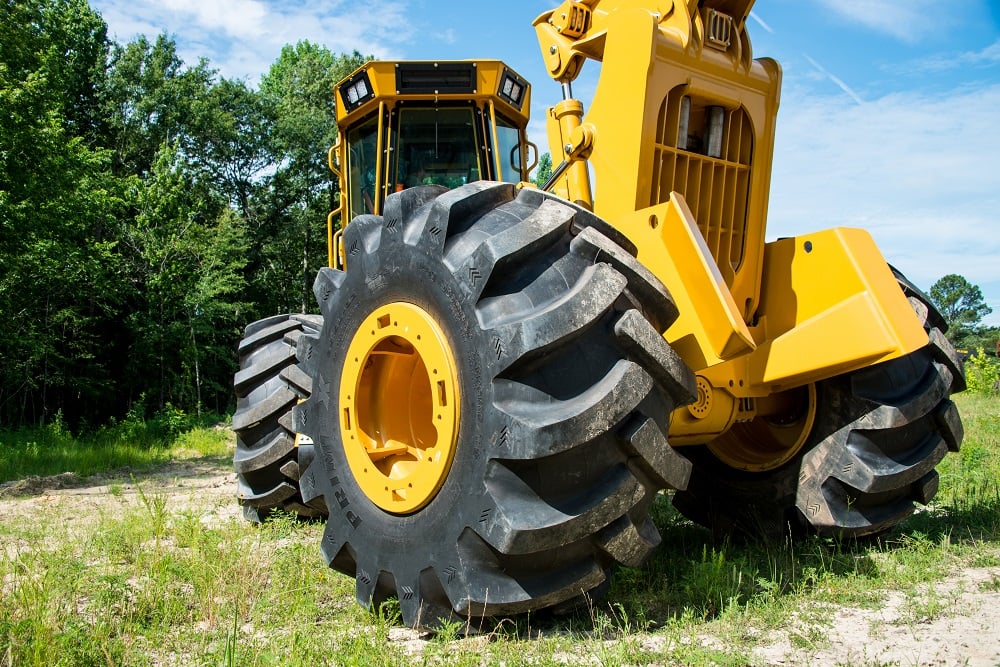Maintenance Tips to Improve the Service Life of Forestry Tires
Forestry tires are a major expense for logging companies, and the cost of new forestry tires can have a significant impact on their profits. Luckily, by taking just a few simple steps, timber harvesters can extend the service life of their tires and keep tire expenditures at a minimum, while also increasing their efficiency and avoiding dreaded downtime.

Why Forestry Tires Maintenance Matters
Logging equipment like skidders and fellers are employed in some of the most extreme conditions imaginable. Their tires must contend with everything from tire-sucking mud, seemingly endless standing water, steep slopes, gouging rocks, and slashing stumps. Forestry tires also work in everything from intense heat to freezing cold, all while managing loads that often exceed 20,000 lbs.
Neglecting to care for forestry tires can lead to a host of problems. At best, poorly cared-for logging tires can lead to a lack of traction, increased tire slip, greater fuel costs, and shorter service life. At worst, it can cause catastrophic failure. According to the corollary of Murphy’s fourth law—If there is a worst time for something to go wrong, it will happen then—issues with your logging equipment’s tires will appear at the most inopportune time, like deep in the forest or up against a deadline.
Inflation Pressure is Extremely Important
The best thing you can do for your forestry tires is to ensure they’re inflated to the correct tire pressure. Underinflated forestry tires can cause excessive heat build-up and potentially lead to damage of a tire’s sidewall, bead, or lining. Operating a tire 10% underinflated can lead to a 10% reduction in service life.
Conversely, overinflated tires are susceptible to cuts in the tread and sidewalls along with impact damage—a particularly unpleasant problem for tires working in terrain littered with stumps, slash, roots, and other debris. Overinflation also causes irregular tire wear and subsequently shortens service life. Too much air can also cause problems for equipment operators—as you can imagine, getting bounced around all day is a recipe for back and neck issues.
Best Practices for Forestry Tire Inflation
Monitoring your forestry tires is crucial to extending their service life, and following a few best practices can further improve your results.
- Frequency: The more regularly you check the inflation pressure of forestry tires, the better results you’ll receive. At a minimum, you should check the inflation pressure of your forestry tires weekly, although daily is ideal.
- Timing: The best time to check inflation pressure is when the tire is cold—what manufacturer recommendations are based on. A cold tire is one that has yet to build up heat from the day’s temperature, sun’s radiant heat, or heat generated while driving, which will temporarily increase pressure. A good rule of thumb is to check inflation at the beginning of every shift and before the machine has run.
- Bogie Tracks: The general rule of thumb if you’re running bogie tracks on your equipment is to set tires to the maximum manufacturer-recommended pressure. This keeps tires from squatting under heavy loads and pushing against the tracks, which can damage sidewalls.
Visual Inspections
Regular visual inspection of tires is another simple step on the path to longer-lasting logging tires. Like monitoring inflation pressure, the more often you perform visual inspections, the better. After all, if you’re checking your tires for damage, you’re a lot less likely to have a surprise issue.
When conducting a visual inspection of your logging equipment’s tires, keep an eye out for these issues:
- Sidewalls: look for any cracks, cuts, or other damage
- Tread: make sure there are no significant chunking, gashes, or splinters
- Bead: remove any branches, splinters, or debris trapped between the tire and the rim (or between duals)
- Valve caps: ensure there are no leaks, cracks, or corrosion
It’s tempting to try to put off a repair or squeeze every hour out of your forestry tires, but it can often cost more in aggravation and downtime than it ultimately saves in dollars. If a tire is damaged or looks as if it’s at the end of its life, repair or replace the tire before it becomes a bigger problem.
Operator Behavior
Operators have an enormous influence on the life of forestry tires. Two causes of expedited forestry tire wear are unnecessary backing up and spinning of tires. These issues are easily avoided by operators taking the time to think about the area they’re working in and planning their routes in advance. Similarly, attentive operation and awareness of potentially damaging stumps and debris can lead to longer-lasting tires.

Application-Specific Tires
Matching tires to the application can have an enormous effect on machine performance, tire life, and, in the end, your bottom line. From super-tough 32-ply tires like our size 30.5L-32 and 35.5L-32 Primex LogMonsters to our Alliance 643 Forestar III, which is designed to work equally well with tracks and chains as it does without, Yokohama Off-Highway Tires has an application-specific forestry tire for your operation. Contact your local YOHTA dealer or rep to learn about our extensive line of forestry tires and how they can help take your logging operation to the next level.

